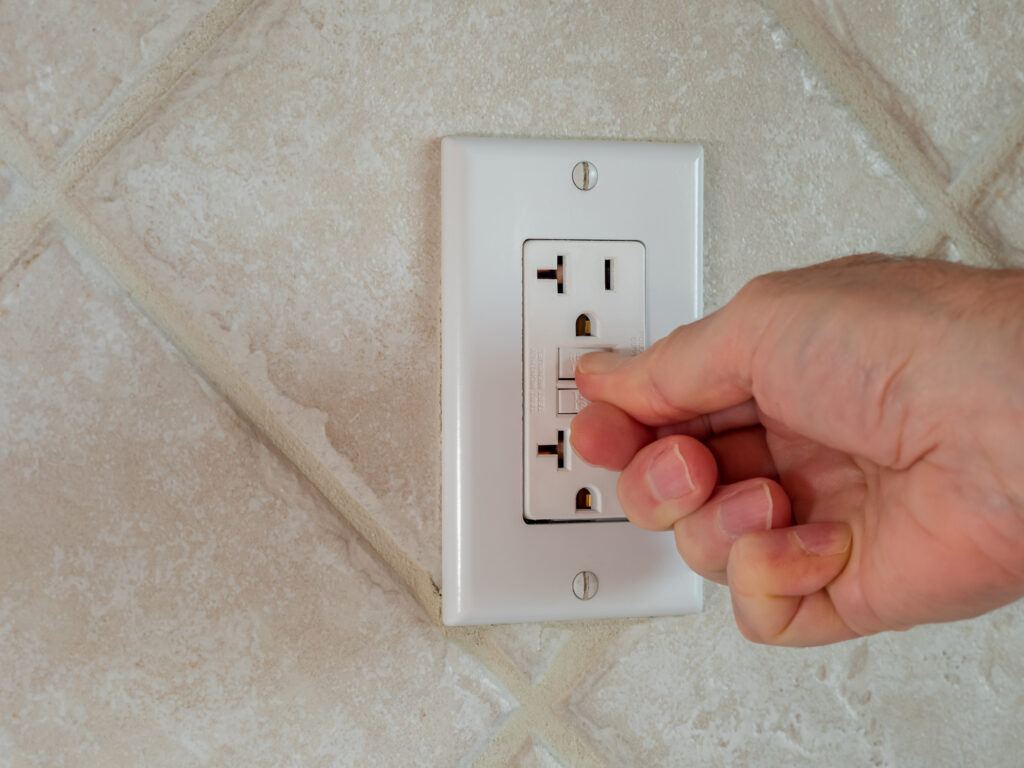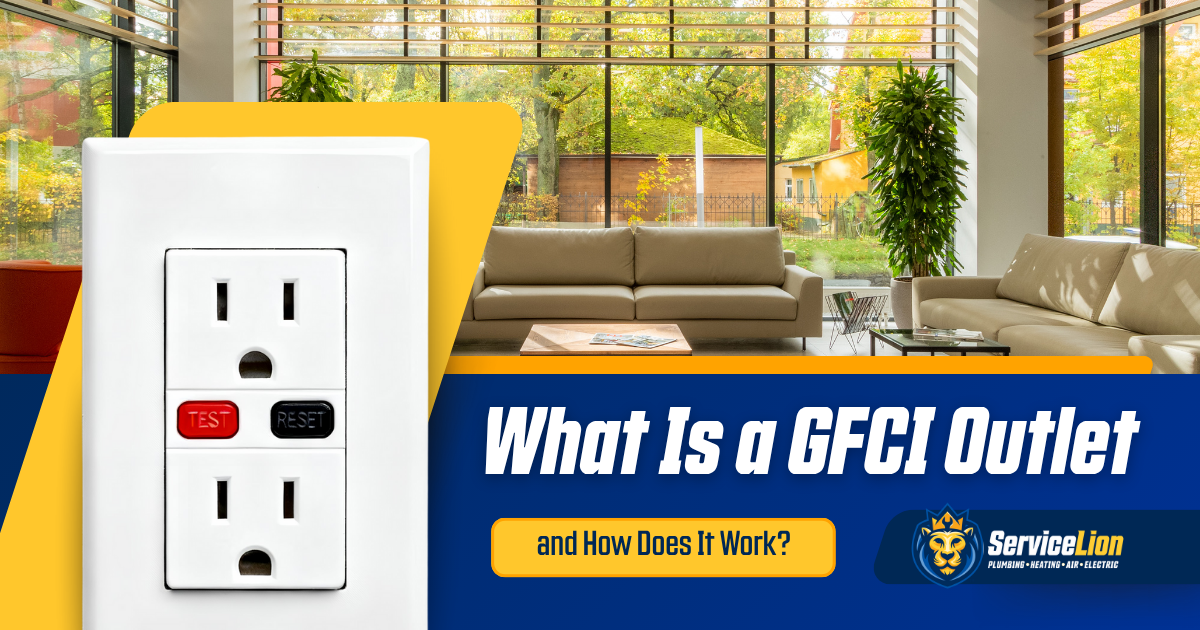Summary at a Glance
- Ground Fault Circuit Interrupter, or GFCI outlets, disconnect power to protect against electrical shock.
- These important outlets detect imbalances in electrical current that occur when the outlet is exposed to moisture or whenever it is damaged.
- GFCI outlets must be installed in any areas of the home located near water, including bathrooms, kitchens, and laundry rooms.
What Does a GFCI Outlet Do in Your Home?
If you live anywhere in Southern California, you may notice a specific type of electrical outlet in your home called a Ground Fault Circuit Interrupter (GFCI). So, what is a GFCI outlet, and what does it do in your home? A GFCI outlet is designed to protect against electrical shock. These vital outlets work by monitoring the flow of current through the hot and neutral wires and disconnecting power when they detect an imbalance. GCFI outlets are required in areas of the home where water is present, such as bathrooms, kitchens, and laundry rooms.

How Does a GFCI Outlet Work to Prevent Shocks?
How does a GFCI outlet work to prevent shocks? Here’s a GFCI outlet explained:
- They monitor electrical current: The amount of electricity flowing through the hot wire in a normal circuit should be equal to the amount running through the neutral wire, and GFCI outlets monitor this flow when in use.
- GFCI outlets detect imbalances: If there is a ground fault, (when a path is created for electricity to escape the intended circuit) GFCI outlets detect the imbalance that occurs.
- They shut off power: Once a GFCI outlet detects a fault, it trips and cuts off the electricity to prevent shock.
- They’re easy to use: If your GFCI outlet trips, simply press the “reset” button to turn it back on, or press the “test” button to test the outlet’s functionality.
Where Are GFCI Outlets Required in a House?
These outlets are required in any areas where water or excess moisture is present. Here’s where GFCI outlets typically are in a home.
- Since all electrical outlets in bathrooms are exposed to water, GFCI outlets are required in these areas.
- Specific areas of the kitchen, including all 15- and 20-amp receptacles on kitchen countertops, electric ranges, dishwashers, wall-mounted ovens, and counter-mounted cooking appliances.
- Outlets located in unfinished basements, crawl spaces, garages, sheds, and other accessory buildings need GFCI outlets.
- Any outdoor receptacles must be GFCI-protected and may also require weatherproof covers.
- Outlets near wet bar sinks, water heaters, hot tubs, and in laundry rooms must have GFCI protection.
What’s the Difference Between a GFCI and a Regular Outlet?
Both regular and GFCI outlets work the same in terms of supplying electricity to appliances and devices. However, a regular outlet does not have any built-in safety features that prevent electrical shock like a GFCI outlet does. Most regular outlets are also smaller in size and don’t have the “test” and “reset” buttons that come with GFCI outlets, and they can be installed anywhere, although they’re considered a safety risk when installed near water.
As for a GFI vs a GFCI outlet, the two devices are technically the same. The only main difference is the acronym used, as GFI stands for Ground Fault Interrupter. Otherwise, these two outlets are exactly the same and serve the same purpose.
How to Test and Reset a GFCI Outlet
Now that you know why GFCI outlets are required, here’s how to test and/or reset your GFCI outlet.
How to test
- Step one: Plug a device like a small lamp or appliance into the GFCI outlet.
- Step two: Press the “test” button located on the face of the outlet.
- Step three: Check the light on the plugged-in device, which should turn off.
- Step four: If the light on the device does not turn off, the GFCI outlet may be defective and should be replaced by an experienced electrician as soon as possible.
How to reset
- Step one: Press the “reset” button located on the GFCI outlet.
- Step two: Listen carefully for a clicking sound as the outlet resets.
- Step three: Check for power by confirming that the device you plugged in has turned back on.
- Step four: If the device doesn’t turn back on, the outlet may be defective, or the circuit breaker in your main electrical panel may have tripped and should be reset.
Can I Replace a Regular Outlet with a GFCI Outlet Myself?
One of the most important benefits of GFCI outlets is that they protect you and your family from serious electrical shock. If you’re thinking of replacing the regular outlets in your home with GFCI outlets yourself, you must know and understand some key safety precautions and electrical concepts. If you choose DIY electrical outlet replacement, always start by turning off the circuit breaker that supplies power to the outlet before continuing, and use a voltage meter to confirm that the power is off. We highly recommend calling the professionals at Service Lion to make sure that everything is done to code and as safely as possible.
Why Choose Service Lion for GFCI Outlet Installation in Orange County?
There are many reasons to choose Service Lion for your GFCI outlet installation needs in Orange County, including:
- Our years of expertise: Service Lion has provided professional electrical services to customers in Orange County for over a decade, making us the premier local company for all of your electrical needs.
- Our flexible financing options: We offer affordable monthly payment options for approved customers for most of our electrical services to make paying for your next service easy.
- Our wide range of services: Not only do we provide a variety of electrical services, but we also offer plumbing services, drain and sewer services, HVAC services, and more.
- Our discounts and specials: Check our electrical specials page to find a range of discounts and coupons to help you save on your next service with us.
Service Areas in Orange County
Service Lions proudly serves customers in Brea and many surrounding Orange County communities, including:
- Brea: 92821
- Irvine: 92618
- Newport Beach: 92660
- Anaheim Hills: 92807
- Orange: 92865
Keep Your Home Safe with GFCI Outlet Installation in Orange County
If you need professional GFCI outlet installation, trust the experts at Service Lion. We’re proud to serve our customers in Orange County and the surrounding areas. To find out more or to schedule service, contact us today!
Frequently Asked Questions
How can I tell if an outlet is a GFCI outlet?
All GFCI outlets have a “test” and “reset” button located on the face. They may also have a small red or green light to indicate the status, and may feature a label that says “GFCI PROTECTED” for easy identification.
Why do my GFCI outlets keep tripping?
If your GFCI outlets keep tripping, it may be due to an electrical fault caused by moisture, a faulty appliance, damaged wiring or outlet, or an overloaded circuit.
How long do GFCI outlets usually last before they need replacement?
Most new GFCI outlets last between 10 to 25 years before they need to be replaced. However, they may need replacement sooner due to heavy use or exposure to moisture, frequent changes in electrical current, or damage.


